Standing on the steps of Revolution Hall this summer in Portland, Devin Boss held a bullhorn and spoke to a crowd of thousands packing the streets around the building.
“As soon as we lock arms like this night here, we show them they ain’t untouchable. Y’all gonna get touched, y’all gonna see those bars,” Boss said, railing against police impunity. “When MLK was assassinated do you remember how they marched? It wasn’t one day. It wasn’t two days. It was weeks.”
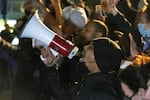
Devin Boss speaks to a crowd of thousands gathered at Revolution Hall after a racial justice march through Portland on June 1, 2020.
Jonathan Levinson / Jonathan Levinson
The crowd, standing shoulder to shoulder for more than a block in every direction, erupted in cheers. Demonstrators sat on the tops of cars and the roofs of buildings.
It was just before midnight on June 1. Two days before, a few thousand demonstrators had marched about four miles from Peninsula Park in North Portland to the Multnomah County Justice Center downtown, kicking off a months-long uprising in Portland against systemic racism and police violence.
Much like the rest of the country, outrage over police violence reached a tipping point in Portland after Minneapolis officers choked George Floyd to death. Black activists in Portland quickly mobilized massive crowds and made explicit policy demands for city and state leaders to advance racial justice.
This week marks six months since Floyd’s death, and protests continue in Portland. But now, activists in the city are divided as to whether they are still fighting in a racial justice movement centered on Black lives, or if an unfocused, anti-establishment fight against capitalism and state power has usurped the initial cause that brought thousands of Portlanders into the streets.
Instead of mass mobilizations focused on disrupting city streets and educating the public, recent protests draw a few dozen people who have regularly engaged in vandalism against such disparate targets as a Democratic Party office, the Oregon Historical Society and the Mexican consulate.
Their most recent action: a Friday protest that ended in vandalism to 27 businesses in the city, ranging from a smoke shop and food carts to a bank branch and an insurance company.
Canceled leaders
Standing next to Boss at Revolution Hall in those early days was Darren Golden. The two had sprung onto the scene that night as leaders in the nascent movement that would eventually put one of the whitest cities in the country at the vanguard of the fight for Black lives.
The two helped form the group Rose City Justice, which brought thousands into the streets for weeks to demonstrate. Marginalized community members spoke about their experiences with racism. Black leaders like City Commissioner Jo Ann Hardesty came out to speak to the crowd, as did Black labor activists, immigration advocates, college professors and a member of the Black Panthers.
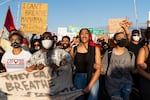
Thousands of racial justice protesters march across the Burnside Bridge on June 3, 2020.
Jonathan Levinson / OPB
“We always made sure that Black faces were in the front and ... it was beautiful,” Boss said. “And then a lot of it slowly started seeping away. A lot of whiteness started seeping into the forefront. A lot of white voices started seeping into the front.”
Boss and Golden would also prove to be lightning rods in the local activist scene. They were among the first leaders to be toppled by a tumultuous protest movement that is defiantly leaderless and rife with subplots, cliques and personality conflicts.
“There was just a lot of beauty and genuineness that happened in the beginning of this movement,” Boss said.”A lot of that faded away relatively quickly and turned into power dynamics.”
A little more than three weeks into the protests, an anonymous Twitter account spread old tweets of Golden being disrespectful to women. His LinkedIn profile started making the rounds online, showing he had been in the Air Force security forces, the branch’s military police equivalent. Golden guarded nuclear weapons in the Air Force, but as he became more well known as an organizer, critics quickly accused him of being a former police officer and collaborating with law enforcement.
“I was targeted directly,” he said. “Somebody went back seven years on my Twitter account, through tens of thousands of tweets, to find something that they found incendiary. And they coupled that together with other stuff from when I was 20 and 19 and made this kind of collage of why Darren can’t lead a movement or be a part of a leadership of RCJ moving forward. So it was extremely targeted.”
Slowly, the organizers and activists who had been speaking to massive crowds at Revolution Hall and Pioneer Square started pulling back. The organizing force that mobilized the community to send nearly 80,000 emails to city commissioners demanding cuts to the police budget, faded.
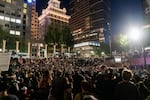
Thousands of racial justice protesters gathered in Pioneer Square to listen to speakers and demand action on police violence and systemic racism on June 1, 2020.
Jonathan Levinson / OPB
Golden points to the June budget vote, when community pressure helped pave the way for what city leaders described as a $15 million cut from Portland police coffers. That same level of pressure didn’t materialize in November when further cuts were on the table and ultimately voted down.
“I think all of the people who were being effective were canceled for one reason or another,” Golden said. “You can say ‘fuck the police’ till you’re blue in the face. You’re not going to change the system. You have to go to the individual that makes the laws for them, and that’s not happening right now.”
Neither Boss nor Golden knows who initially targeted Rose City Justice, but they both voice a common frustration with how the racial justice movement evolved in Portland: At some point, it stopped being about racial justice and started being anti-establishment.
“We’ve seen this happen over decades, over centuries,” Golden said. “Black folks that get in power or have a voice are somehow squashed or quelled by a white political leadership or white organizing.”
Privilege, anonymity and tactics
Gregory McKelvey made his name in 2016 organizing disruptive, street-level protests in the days and weeks after Donald Trump was elected president. Four years later, McKelvey had taken his activism into the political arena, running Sarah Iannarone’s insurgent mayoral campaign to topple Ted Wheeler.
Though Iannarone did not win, the McKelvey-led campaign helped make policing and equity issues in Portland into one of the primary topics of the election.
“Most Black people in our community don’t feel like they have the privilege to go straight to the police and yell in their face,” McKelvey said. “If you’re privileged, if you’re white, you care less about whether or not a protest is going to result in reforms that might save even just one life. And you have the ability to be a purist in a way that Black and brown communities really do not.”
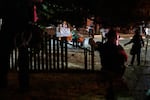
Protesters gathered in front of the Portland Police Association on day 68 of protests against systemic racism and police violence.
Jonathan Levinson / OPB
Disputes over protest tactics this year have spilled into the online space, where organizing for street events took place.
A number of anonymous activist social media accounts undermined and criticized groups that used less aggressive tactics, while feeding the more radical elements of the protest movement. For months, an anonymous Twitter account calling itself the Pacific Northwest Youth Liberation Front has been a repository for organizing information, helping to spread anarchist propaganda, advocating violence and encouraging followers to “burn down the American plantation.”
The Liberation Front account tweeted in July criticizing Rose City Justice for “pacifying the nightly justice center action,” and admonished its followers to “stop blindly listening to people with megaphones.”
The next day, the account again tweeted about the group, calling them police collaborators.
PNWYLF’s rhetoric also made it an easy target for city leaders and conservative commentators looking for a way to try to delegitimize protests wholesale. As recently as this month, FOX News published a story titled “Antifa-aligned group cheers alleged arson at police officer’s home,” based on a single tweet from the account.
Multiple sources confirmed to OPB that its Twitter account, long shrouded in mystery, was started and run by a white teenager who grew up in suburban Portland. That person said they’ve since moved on from the group.
But while PNWYLF lingers in the shadows, encouraging violence and property destruction in the name of racial justice, its anonymity stands in contrast to Black and brown activists who find it impossible to conceal their identity in an overwhelmingly white city.
“When we get dragged out by the cops, it’s easy to identify a Black person within Portland, even if they have their mask on.” Wright said.
“A lot of the time,” said Eli Deschera, a Black activist who founded an organizing group called the Radical Justice Party, “it’s the younger crowd that believes that you shouldn’t police other people’s protests. And in turn, they are the reason why so many people are getting arrested and injured.”
Deschera said he thinks the potential of the nightly Black Lives Matter marches was squandered by people who were in it for the wrong reasons.
“It’s really disheartening to see something that was so beautifully brought together and had such great potential just get essentially demolished by all these white high school kids that live in the suburbs,” he said.
Not entirely Black and white
Tensions between Black activists fighting for racial justice and anti-establishment protesters have bubbled beneath the surface for months. And while anarchist groups in Portland are predominantly white, the dynamics are more complicated than Black versus white activists — a point that has befuddled politicians, media commentators and onlookers trying to understand who is leading protests and what their goals are.
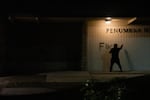
A protester in black bloc spray paints the Penumbra Kelly building in East Portland.
Jonathan Levinson / Jonathan Levinson
Early on, city leaders tried to distinguish between the “good protesters” and “bad protesters” in their public statements, labels activists of every stripe continue to roundly reject even today. From the earliest protests this summer, Black organizers were careful not to condemn the variety of tactics being employed, even if they themselves chose different approaches. Some Black organizers found helpful allies among the more radical groups.
Plus, anarchist protesters aren’t a homogenous group or all white.
“I was against window breaking not even that long ago because it just looks bad,” said Tracey Molina, an Indigenous anarchist who was among the early protesters at the Justice Center. “Real mom and pop businesses, I think they should be left alone. They’re there with us. They’re in the struggle.”
But Molina reserves no sympathy for large corporations and billionaires.
At an October protest described as an “Indigenous day of rage,” she remembers watching as protesters pulled down statues.
“The first statue that got pulled down was Teddy Roosevelt on a horse. I was like, ‘No,’” she said, recalling with disgust the racist things Roosevelt said and did, while also appreciating that he created national parks.
“I felt conflicted for a minute when they were putting the chains up on it,” Molina said. “And then I was fine because this country has been terrible to the native people.”
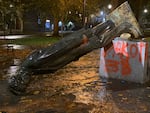
Protesters in Portland toppled multiple statues, including this one of President Abraham Lincoln, on Sunday, Oct. 11, 2020, during an event they called "Indigenous People's Day of Rage."
Sergio Olmos
The following day, President Trump retweeted a photo of Molina standing over the toppled Roosevelt statue with a caption: “Put these animals in jail, now.”
“It’s troublesome or hurtful that people care more about a statue than they do the living injury of the original people whose land they’re on,” Molina said. “I think they should be preserved in places like museums and private property, but why should descendants of their victims have to see that every day?”
Who do you protect? Who do you serve?
The belief that some protests were no longer focused on racial justice had been unspoken for months but was finally brought into the open Nov. 4, when a Black Lives Matter march crossed paths downtown with a group of anarchist protesters. The BLM group asked the anarchists to join their non-violent march for the night.
Kevin Wright, who has protested in peaceful marches and “direct actions” that encouraged vandalism, stood on the back of his truck watching the two separate groups converge at an intersection, both chanting Black Lives Matter, both refusing to march together.
Wright told the crowd, mostly dressed in black, some wearing helmets, that they have an opportunity to unite. He was met with unenthusiastic cheers.
“I didn’t understand,” said Wright, who is Black and was there initially with the anarchist group. “It made no sense for the two protests not to be together, especially if the end goal is for Black civil rights.”
For four years, Portland activists had mobilized in resistance to actions by the Trump administration. But the day after the election, with Trump’s defeat looking more certain, groups were not merging to celebrate toppling a shared nemesis. Instead, they split.
Racial justice activists told Wright they were afraid that if windows were broken or property destroyed, it would be framed as racial justice protesters committing acts of vandalism.
“The problem is breaking stuff,” Wright asked. “If we just don’t break stuff for one night, can we come together?”
He got on a microphone and tried to convince the mostly white, black-clad group of anarchists to refrain from doing what they seemingly had shown up to accomplish.
“For tonight, don’t break stuff,” Wright pleaded. “Stand with Black people. Set an example when Black people and Black organizers ask you to stand with their revolution.”
Some in the crowd cheered, but others turned away. Under the Burnside Bridge, Wright heard a smaller group of anarchists debating what to do next.
“I definitely heard them say, ‘We’re not here to just listen to Black people. We have no leaders, no one decides to tell us what to do.’”
The anarchists split away, smashing windows of businesses indiscriminately, prompting the governor to send in the National Guard.

Anarchist protesters vandalized a Portland Starbucks on Nov. 2, 2020.
Sergio Olmos
Andre Miller, a 37-year-old activist who co-founded a racial justice organization called J.U.I.C.E., was with the racial justice protesters that night.
He’s been out protesting this year since the end of May, first helping to organize marches in early June, and later providing medical help and mutual aid during the more violent weeks of July and early August. In July, he was hospitalized after federal law enforcement officers hit him in the head with an impact munition.
Hearing that the anarchist group did not want to work with Black activists only added to the frustration Miller said he started to feel after federal officers pulled back significantly from Portland in August.
He said protests began to feel directionless, and while people are free to protest however they want, the anarchist actions felt less concerned with accomplishing changes for Black Oregonians.
“You got people in black bloc gear, they can go the next day and be able to go to their job, or go to their school, and be able to live their white life,” Miller said. “Whereas, when the protests die down, I’m still going to be a Black man. And I’m still gonna have the encounters with police. I still have four children that are still going to have encounters with police.”
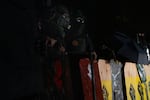
Protesters conceal their identity and hold shields to protect from police impact munitions during a demonstration at the Penumbra Kelly building in East Portland.
Jonathan Levinson / Jonathan Levinson
Miller spent the four years before George Floyd’s death in a drawn-out fight with the North Clackamas School District. He wanted accountability after one of his children was called a racial slur at school. But it wasn’t until protests started, and the Black community suddenly had a larger platform with a more receptive audience, that school officials were held accountable. Legislation is being drafted currently to allow students to sue the school district for instances of harassment and discrimination that go unaddressed.
Miller’s is just one example of how sustained protests in Portland have accomplished what would have seemed infeasible a year ago. Protests have led to cuts to police funds, increased interest in police alternatives, a voter-approved overhaul of officer oversight, and newly attentive segments of Portland’s white majority.
But many Black activists wonder if the recent protest tactics could hamper the fight for racial justice in the year to come.